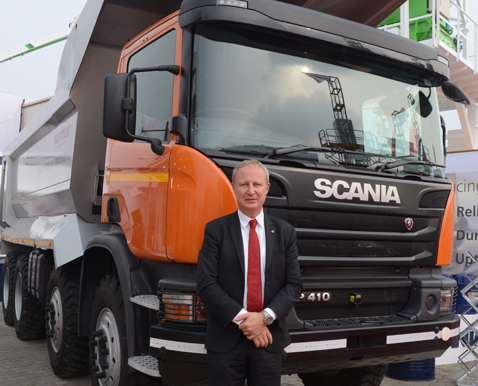
 — Krister Thulin, Presales & Marketing Director, Scania India
— Krister Thulin, Presales & Marketing Director, Scania India
Scania has been represented in the Indian market since 2007. However, in 2011, Scania established Scania Commercial Vehicles India Pvt. Ltd to strengthen its presence in additional segments of the Indian commercial vehicle market. In October 2013, the company inaugurated its Rs.300-crore industrial truck production facility at Narasapura, Bengaluru. Krister Thulin spoke to Sandeep Menezes on what will drive the Indian truc market in coming years.
Last year saw the Indian trucking market going through a tough phase of de-growth. How is the market currently?
Yes, the market has been low. But we foresee the mining industry especially picking up which will continue in the months ahead. We feel that next year the mining market may grow up to 10 times.
What will be the main growth drivers for the trucking industry in the years ahead?
I feel that once GST is in place then it will open up business between the various states. Currently, one needs to stand at borders between the various states. Once this opens up then we will see a lot of flow in the market.
Few other premium global trucking brands have launched affordable mass-market models in India to increase market penetration. Does Scania intend to follow the same path?
No, because we don’t need that segment. We are already priced lower per kilometre with Scania as compared to other competitors. Therefore, we don’t need to go into the value market.
But the Indian customer still looks at the initial acquisition price rather than at the lifecycle cost of trucks.
Yes, they most look at only the initial acquisition price but we have a few customers who understand lifecycle cost of trucks.
In segments wherein the trucks are used a lot of the time, our uptime is best in the market which is itself value for money.
What is the current market size for premium trucks in India?
Today, the market size is roughly about 1,000 trucks per year, but this should grow to roughly about 5,000 trucks in the coming years.
There is an increasing trend towards localisation of products. Can you tell us about Scania’s plans to localise in India?
We already localise around 25 per cent of the truck and 80 per cent with the bus. We always try to localise but also have to keep in mind global standards.
Isn’t 25 per cent localisation of truck rather meager?
Yes, but we don’t localise if we don’t find the same Scania quality what we have worldwide because the brand can’t be ruined. It’s a premium brand so it must have the same quality even if one buys it in India, Sweden or South America.
In the coming five years, we intend to increase localisation of our truck from 25 per cent to 60 per cent.
What bout Scania’s current exports?
We already export currently to SAARC countries such as Sri Lanka, Bangladesh, Nepal and Bhutan.
Most global OEMs launch stripped-down versions of their products devoid of many features to compete on pricing with local players in India.
If we can take away some options then it is always there but we will never compromise on quality. Like, if the customer may not want electric windows or fancy seats, then it can be looked into.
Can you throw light on Scania’s future plans in India?
We will introduce more models of Scania Metrolinks. Also, seater buses running on biofuel will be introduced this year.
Our current factories can produce all those types of vehicles but if we go above 2,500 trucks and 1,000 buses then we need to expand. Within next two to five years as volumes increase, we will go in for a brownfield expansion at our current manufacturing plant.











